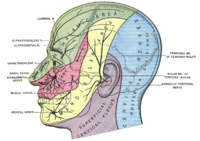
Photo from wikipedia
Temporomandibular joint disorders (TMDs) are conditions that affect the muscles of mastication and joints that connect the mandible to the base of the skull. Although TMJ disorders are associated with… Click to show full abstract
Temporomandibular joint disorders (TMDs) are conditions that affect the muscles of mastication and joints that connect the mandible to the base of the skull. Although TMJ disorders are associated with symptoms, the causes are not well proven. Chemokines play an important role in the pathogenesis of TMJ disease by promoting chemotaxis inflammatory cells to destroy the joint synovium, cartilage, subchondral bone, and other structures. Therefore, enhancing our understanding of chemokines is critical for developing appropriate treatment of TMJ. In this review, we discuss chemokines including MCP-1, MIP-1α, MIP-3a, RANTES, IL-8, SDF-1, and fractalkine that are known to be involved in TMJ diseases. In addition, we present novel findings that CCL2 is involved in β-catenin-mediated TMJ osteoarthritis (OA) and potential molecular targets for the development of effective therapies. The effects of common inflammatory factors, IL-1β and TNF-α, on chemotaxis are also described. In conclusion, this review aims to provide a theoretical basis for future chemokine-targeted therapies for TMJ OA.
Journal Title: Genes
Year Published: 2023
Link to full text (if available)
Share on Social Media: Sign Up to like & get
recommendations!